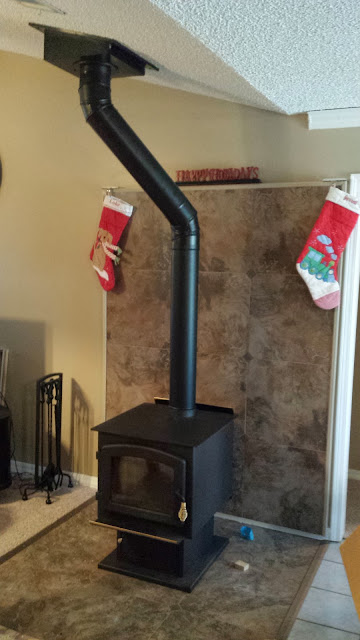for the back story on this, see my previous thread first.
This morning, on an "ok" bed of coals...(took a little bit, but it finally caught fire ok), i reloaded 4 good splits, opened the bypass, opened the air to 100%.
immediately upon opening the stove door, i heard the flakes coming down the pipe, like i have been lately since burning the fires hotter at good temps.
I have the door cracked because of the amount of coals i had, just to give them a bit more air to generate enough heat to ignite. After ignition, the temps get up around 400F, and i start to hear a constant tinkling. i shut the door, the tinkling stops.
I open the door again, the tinkling immediately starts again. I shut the door, i shut the bypass. waited about 5 minutes. flue temp hadnt changed up or down, staying at a steady 400. Single wall duravent telescopic piece, first ~30 degree elbow, another 2 foot section of single wall, 2nd ~30 degree elbow thats attached to the support box. see photo below.

While waiting the 5 minutes with the bypass shut, with the door shut, I walk outside and there is zero smoke coming out of the chimney, past few weeks been really cold and really windy. i walk back inside, crack the door and IMMEDIATELY i can hear the tinkling, sounds like flakes falling down. well with the door open, i put my head close to the stack, and listen....i start to hear sizzling!! so i run outside, and now i see a little bit of black smoke....and every once in a while, a flake of black would spit out and fall down on the roof. Ran inside, shut the door, tinkling stopped, went back outside, back to no smoke...
so this tells me its for sure its on fire right? as soon as i shut the door, the sizzling stops, the flakes/tinkling stops. bumping the stack would make more flakes fall down but with diminishing returns. i dont get it, ive been getting good clean burns at night, yet these flakes happen in the morning, and when i get home in the evenings.
i know i started off with bad burning practices on this stove, but since them i thought i had a good handle on the fires buring nice and clean. like i said, i can get zero smoke now with each fire. so i dont understand this at all, unless its just flaking off what has built up while burning dirty.
all this was installed by me, the week before Christmas. i will scrub everything out good saturday morning, but i guess im going to let the fire die out before i do. gonna disconnect the stack take it outside and inspect, and scrub it from the top down. all i have is a wire brush and sticks.
i just wish i knew what the inside of the pipes looked like when this was happening.
This morning, on an "ok" bed of coals...(took a little bit, but it finally caught fire ok), i reloaded 4 good splits, opened the bypass, opened the air to 100%.
immediately upon opening the stove door, i heard the flakes coming down the pipe, like i have been lately since burning the fires hotter at good temps.
I have the door cracked because of the amount of coals i had, just to give them a bit more air to generate enough heat to ignite. After ignition, the temps get up around 400F, and i start to hear a constant tinkling. i shut the door, the tinkling stops.
I open the door again, the tinkling immediately starts again. I shut the door, i shut the bypass. waited about 5 minutes. flue temp hadnt changed up or down, staying at a steady 400. Single wall duravent telescopic piece, first ~30 degree elbow, another 2 foot section of single wall, 2nd ~30 degree elbow thats attached to the support box. see photo below.

While waiting the 5 minutes with the bypass shut, with the door shut, I walk outside and there is zero smoke coming out of the chimney, past few weeks been really cold and really windy. i walk back inside, crack the door and IMMEDIATELY i can hear the tinkling, sounds like flakes falling down. well with the door open, i put my head close to the stack, and listen....i start to hear sizzling!! so i run outside, and now i see a little bit of black smoke....and every once in a while, a flake of black would spit out and fall down on the roof. Ran inside, shut the door, tinkling stopped, went back outside, back to no smoke...
so this tells me its for sure its on fire right? as soon as i shut the door, the sizzling stops, the flakes/tinkling stops. bumping the stack would make more flakes fall down but with diminishing returns. i dont get it, ive been getting good clean burns at night, yet these flakes happen in the morning, and when i get home in the evenings.
i know i started off with bad burning practices on this stove, but since them i thought i had a good handle on the fires buring nice and clean. like i said, i can get zero smoke now with each fire. so i dont understand this at all, unless its just flaking off what has built up while burning dirty.
all this was installed by me, the week before Christmas. i will scrub everything out good saturday morning, but i guess im going to let the fire die out before i do. gonna disconnect the stack take it outside and inspect, and scrub it from the top down. all i have is a wire brush and sticks.
i just wish i knew what the inside of the pipes looked like when this was happening.


